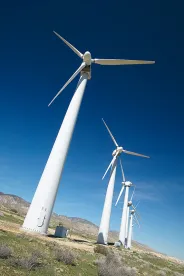The U.S. Fish and Wildlife Service (FWS) recently changed its eagle “take” permitting rules to allow wind developers to apply for 30-year take permits; previously, such permits, which allow the incidental killing of eagles, were available for a maximum of just five years. Wind developers had lobbied for the rule change based on concerns that shorter permitting periods inhibit their ability to obtain financing. But now, a bird conservation group, the American Bird Conservancy (ABC), is threatening litigation to overturn the “30-Year” rule.
How strong are ABC’s claims?
Not especially strong, because the FWS has powerful responses to each of ABC’s contentions. The FWS will also be protected by the deferential standard of review that typically applies in this type of lawsuit. And even if ABC were to prevail on its claims, the end result is less likely to be wholesale revocation of the rule than some delays in implementing it. That is because ABC’s claims are largely procedural in nature, not substantive.
ABC’s claims are summarized in an April 30 letter to the U.S. Department of the Interior and the FWSannouncing the group’s intention to file suit over the 30-Year rule. The letter contends that the FWS committed three legal errors when it extended the maximum take permitting period from five years to 30 years. According to ABC, the FWS violated: (1) the National Environmental Policy Act (NEPA), by failing to prepare an environmental impact statement or environmental assessment for the 30-Year rule; (2) the Endangered Species Act (ESA), by allegedly failing to ensure that the rule is not likely to jeopardize the continued existence of endangered species; and (3) the Bald and Golden Eagle Protection Act (BGEPA), which is the statute that authorizes take permits, by prioritizing the concerns of wind developers over those of the eagles the statute is designed to protect.
The problem for ABC – and the good news for wind developers – is that FWS has strong defenses to ABC’s assertions. First, the NEPA claim will almost certainly turn on whether the FWS correctly concluded that the 30-Year rule falls within a “categorical exclusion” from NEPA’s requirements. In its letter, ABC quibbles with the FWS’s conclusion, but courts generally review such conclusions under a highly deferential standard of review. Indeed, agencies often prevail on such claims simply by offering a facially plausible explanation of why NEPA does not apply. Here, the FWS has done that. The agency’s NEPA implementation regulations permit the FWS to forego NEPA analysis for rules that have broad or speculative impacts, provided that those impacts will be analyzed on a case-by-case basis in the future. The FWS contends that is the situation here – it will conduct a NEPA analysis on a permit-by-permit basis in the future. Courts have rejected NEPA claims under similar circumstances in the past.
The FWS has a similar defense to ABC’s ESA claim. That claim turns on whether the FWS had a duty to engage in internal consultation about the potential impact of the 30-Year rule on endangered species or critical habitat. ABC’s letter insists that the FWS was subject to that duty and failed to comply with it. But the FWS previously concluded, in 2009, that the eagle take permitting rule as a whole would not have any impact on endangered species. That leaves the FWS in a strong position now, because the 30-Year rule does little more than change the maximum available permitting period under the existing permitting rule. The FWS will also likely argue that, contrary to ABC’s assertions, the 30-Year rule does not affect endangered species because all it does is authorize the issuance of permits, it does not itself grant any developer permission to undertake any activity. In sum, the FWS will likely argue that the proper time for ESA consultation is in the context of specific permit applications in the future, not in the context of this more general rulemaking that is not project-specific.
Finally, although ABC insists that the FWS should not have privileged the interests of wind developers over the protection of eagles, that is probably not enough to establish that the 30-Year rule violates the BGEPA. The BGEPA expressly allows the FWS to permit eagle takes “for the protection of . . . other interests in any particular locality.”
ABC will likely wait 60 days before actually commencing litigation, so as to comply with the ESA’s citizen suit provision. In the interim, the FWS will surely be evaluating the merits of ABC’s contentions and considering what options it has for addressing them. Wind developers may want to make their voices heard during that 60 day period, and may want to consider intervening to defend the 30-Year rule in the event this matter does in fact proceed to litigation.




 />i
/>i

